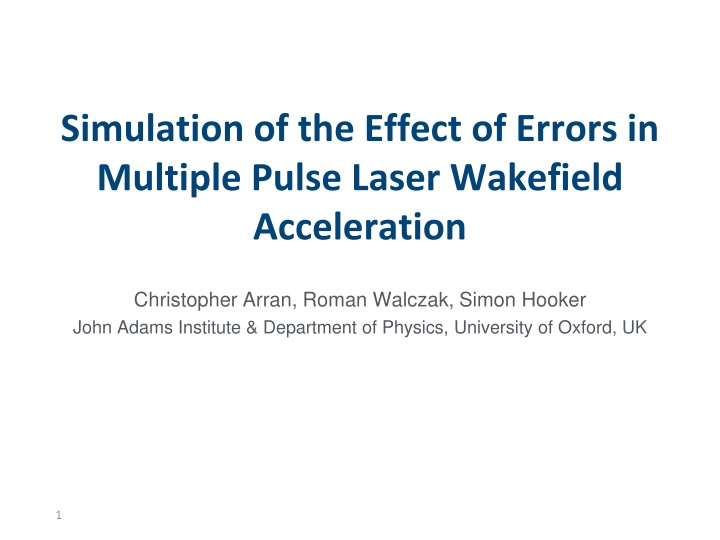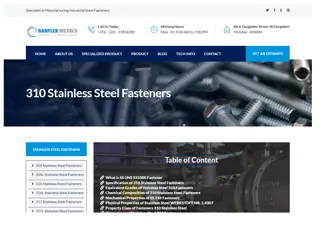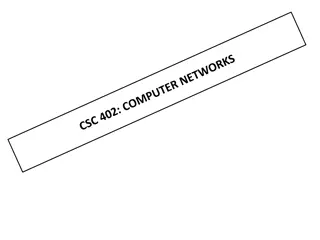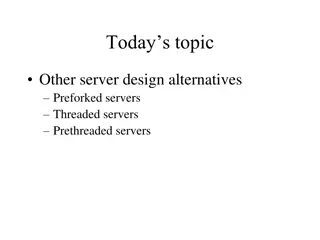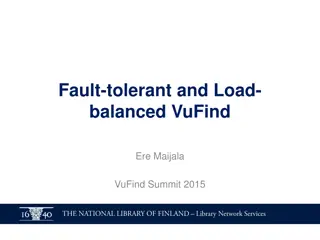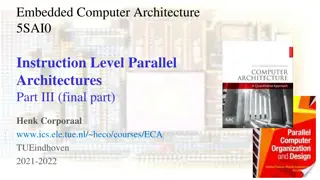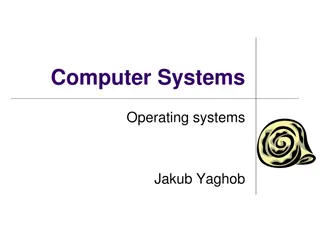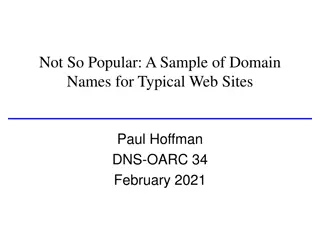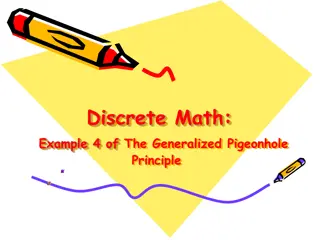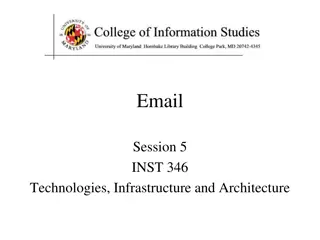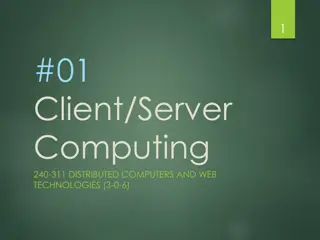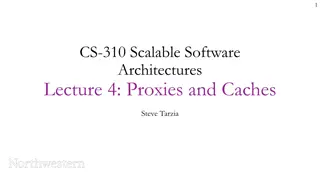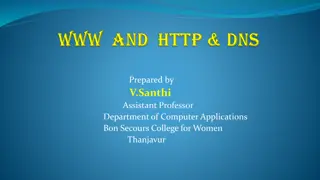CS-310 Scalable Software Architectures Lecture 2: HTTP and Web Servers
This lecture covers the basics of scaling software services, comparing vertical and horizontal scaling approaches, defining services versus programs, and transitioning programs to services. It also discusses network translation, service threading, concurrency, and web/HTTP server frameworks.
Uploaded on Mar 02, 2025 | 0 Views
Download Presentation

Please find below an Image/Link to download the presentation.
The content on the website is provided AS IS for your information and personal use only. It may not be sold, licensed, or shared on other websites without obtaining consent from the author.If you encounter any issues during the download, it is possible that the publisher has removed the file from their server.
You are allowed to download the files provided on this website for personal or commercial use, subject to the condition that they are used lawfully. All files are the property of their respective owners.
The content on the website is provided AS IS for your information and personal use only. It may not be sold, licensed, or shared on other websites without obtaining consent from the author.
E N D
Presentation Transcript
Simulation of the Effect of Errors in Multiple Pulse Laser Wakefield Acceleration Christopher Arran, Roman Walczak, Simon Hooker John Adams Institute & Department of Physics, University of Oxford, UK 1
Overview Why is the Multiple Pulse technique needed? What are the effects of errors in pulse train spacing? Systematic - tuning Random - jitter How well do we need to control these errors? Develop simple analytic theory and compare to PIC simulations Christopher Arran University of Oxford 2 EAAC 2015, Isola d Elba, 14 - 18 Sep 2015
Motivation Current laser systems use single laser pulses Energy few J, Pulse duration tens of fs But repetition rates and efficiencies very low eg. Ti:sapphire: Rep rate < 10 Hz, Efficiency < 0.1% wall-plug (Hooker et al 2014) Many applications require kHz repetition rates BELLA laser, LBNL Credit: Mark Gable Christopher Arran University of Oxford 3 EAAC 2015, Isola d Elba, 14 - 18 Sep 2015
Multiple Pulse-LWFA Use smaller, more efficient laser systems in resonance Several small pulses as effective as one large pulse Higher repetition rates become possible Vital for pulses to remain in resonance with wakefield Throughout both i) pulse train and ii) length of accelerator S. M. Hooker, R. Bartolini et al, J. Phys. B: At. Mol. Opt. Phys. 47 pp. 234003, (2014). Christopher Arran University of Oxford 4 EAAC 2015, Isola d Elba, 14 - 18 Sep 2015
Effect of Pulse Train Spacing In linear regime each pulse produces a sinusoidal plasma wave What happens if these are mistimed with error ??= ??/?p? ??? = ? cos ?p? {? + ??}?p ???=? ?cos ?p? + ? for: ? 2 2 ?2= ?cos 2??? ? + ?sin 2??? = ? + ?=1 Incoherent cos 2?(?? ??) ? ? ? Coherent Now compare to simulations with Particle In Cell code EPOCH Christopher Arran University of Oxford 5 EAAC 2015, Isola d Elba, 14 - 18 Sep 2015
Simulation Parameters Parameters in line with concept paper (Hooker et al 2014) Linear regime, a0 = 0.052 Broad Gaussian pulses, tFWHM = 100 fs Low density, ne = 1.75x1017 cm-3 Plasma wavelength, p = 80 m EPOCH PIC code Resolution 25 cells per feature size ( L = 1 m) 20 pseudo-particles per cell avoids numerical heating Window 80 m to capture exactly one plasma wavelength Output taken once per plasma period, 266 fs 100 repeats over random jitter Christopher Arran University of Oxford 6 EAAC 2015, Isola d Elba, 14 - 18 Sep 2015
Calculating a Wakefield Amplitude Use Fourier amplitude to calculate wakefield amplitude Require a consistent plasma wave, moving with electrons Smoothing is better than a low pass filter Faster than a fitting technique Simulation window of length L = n p Best captures Fourier peak Introduces artefact at beginning Only works close to linear regime Christopher Arran University of Oxford 7 EAAC 2015, Isola d Elba, 14 - 18 Sep 2015
Example Simulation Results Example of a pulse train with added 5% Jitter Non uniform pulse spacing Christopher Arran University of Oxford 8 EAAC 2015, Isola d Elba, 14 - 18 Sep 2015
Random Spacing Error-Jitter Eg. vibrations on optic bench, thermal fluctuations ??~Gaussian 0,? ? Good agreement with theory 10% scale jitter acceptable ? + ?2exp 2??2 ? ? = 0.1 Christopher Arran University of Oxford 9 EAAC 2015, Isola d Elba, 14 - 18 Sep 2015
Systematic Spacing Error-Tuning Eg. target density error, misaligned optics error ??= ?? ? = sin ??? /sin(??) Required accuracy: a < N-1 Limits useful pulse train length: N < (2a)-1 Christopher Arran University of Oxford 10 EAAC 2015, Isola d Elba, 14 - 18 Sep 2015
Autoresonance Set Up Exploit autoresonance to overcome errors R.R. Lindberg, A.E. Charman et al, Phys.Rev.Lett., 93 5, pp. 055001, (2004). Change pulse spacing to pass downwards through resonance Pulse rate chirped: ?pulses= ?initial ??p2? for ?initial> ?p After the ?th pulse at ??, the next separation is ?? ?1+ ??p2?12 (?? ?1) ?3 ?7 2? Example simulation =0.01, 0= 0.9 p ?4 ?3 ?8 ?7 Christopher Arran University of Oxford 11 EAAC 2015, Isola d Elba, 14 - 18 Sep 2015
Autoresonance Results Wakefield frequency becomes locked to driver, not to plasma Pushes wakefield amplitude beyond the detuning limit Wakefield becomes resilient against plasma density fluctuations 1% initial detuning Christopher Arran University of Oxford 12 EAAC 2015, Isola d Elba, 14 - 18 Sep 2015
Conclusions High stability to random jitter ( 10%) But require accurate mean spacing (< 1% for 50 pulses) Requires tuning plasma density within 2% PIC simulations in good agreement with simple linear theory Next steps Experimental demonstration J. Cowley Ion motion further limits pulse train length J. Holloway Investigate autoresonance for resilience to pulse spacing and density error Christopher Arran University of Oxford 13 EAAC 2015, Isola d Elba, 14 - 18 Sep 2015
Thank you Simon Hooker Roman Walczak Laura Corner Gavin Cheung James Cowley Stephen Dann Rob Shalloo Christopher Thornton STFC UK (grant no. ST/J002011/1) Helmholtz Association of German Research Centres (grant no. VH-VI-503) Air Force Office of Scientific Research, Air Force Material Command, USAF (grant no. FA8655-13-1-2141) The EPOCH code was developed as part of the UK EPSRC funded projects (grant no. EP/G054940/1) Christopher Arran University of Oxford EAAC 2015, Isola d Elba, 14 - 18 Sep 2015
Bibliography 1. S. M. Hooker, R. Bartolini et al, J. Phys. B: At. Mol. Opt. Phys. 47 pp. 234003, (2014). 2. L. Corner, R. Walczak et al, AIP Conf. Proc., 1507, pp. 872-873, (2012). 3. R. Walczak, Presentation at LPAW, (2013). 4. R.R. Lindberg, A.E. Charman et al, Phys.Rev.Lett.,93 5, pp. 055001, (2004). 5. R.J. Shalloo, Personal Correspondence, (2015). 6. W. L. Kruer, The Physics of Laser Plasma Interactions, Westview Press, (2003). 7. P. Gibbon, Short Pulse Laser Interactions With Matter, Imperial College Press, (2005). 8. T. Tajima and J. Dawson, Phys. Rev. Lett., 43 4, pp. 267-270, (1979). 9. S. M. Hooker, Nat. Photonics, 7 775, pp. 1-11, (2013). 10. S. P. D. Mangles, C. D. Murphy et al, Nature 431, pp. 535-538, (2004). 11. W. P. Leemans, A. J. Gonsalves et al, Phys. Rev. Lett., 113, pp. 245002, (2014). 12. K. Nakamura, B. Nagler et al, Phys. Plasmas, 14 5, pp. 056708, (2007). Christopher Arran University of Oxford 15 EAAC 2015, Isola d Elba, 14 - 18 Sep 2015
Further Autoresonance Wakefield phase changes smoothly with pulse spacing More work ahead on testing this in realistic density profiles Will plasma waves match between different density regions? Christopher Arran University of Oxford 16 EAAC 2015, Isola d Elba, 14 - 18 Sep 2015
